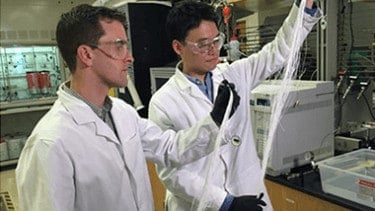A research team from Georgia Tech and ExxonMobil has demonstrated a new carbon-based molecular sieve membrane that could dramatically reduce the energy required to separate a class of hydrocarbon molecules known as alkyl aromatics.
The new material is based on polymer hollow fibers treated to retain their structure — and pore sizes — as they are converted to carbon through pyrolysis. The carbon membranes are then used in a new “organic solvent reverse osmosis” (OSRO) process in which pressure is applied to effect the separation without requiring a phase change in the chemical mixture.
The hollow carbon fibers, bundled together into modules, can separate molecules whose sizes differ by a fraction of a nanometer while providing processing rates superior to those of existing molecular sieve zeolites. Because the new membrane uses a commercial polymer precursor, the researchers believe it has potential for integration into industrial chemical separation processes. The research was reported in the journal Science.
Separation is currently achieved through refining processes such as crystallization and adsorption with distillation, which are energy-intensive. Globally, the amount of energy used each year in conventional separation processes for alkyl aromatics is equal to that produced by about 20 average-sized power plants.
“We see this as a potentially disruptive technology in the way we separate xylenes and similar organic compounds,” said Benjamin McCool, an advanced research associate at ExxonMobil Corporate Strategic Research in Annandale, New Jersey. “If we can make this work on an industrial scale, it could dramatically reduce the energy required by these separation processes.”
Fabrication of the new membrane material begins with hollow polymer fibers approximately 200 microns in diameter, slightly thicker than the average human hair. The fibers have pore sizes of less than one nanometer and are treated via cross-linking before they are converted to carbon through a pyrolysis process.
“We take a scalable platform based on polymeric membranes and then turn those materials into inorganic molecular sieves,” explained Ryan Lively, an assistant professor in Georgia Tech’s School of Chemical and Biomolecular Engineering. “Our membranes are mechanically robust, and they can withstand the process conditions required by OSRO.”


